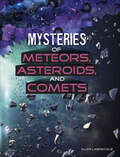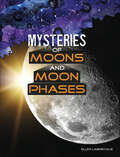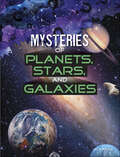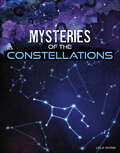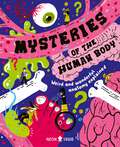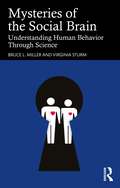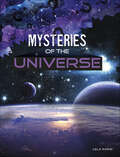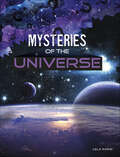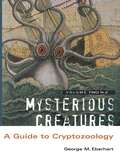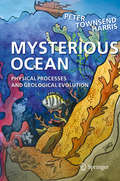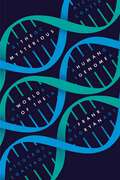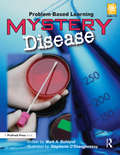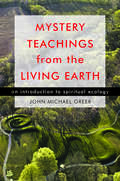- Table View
- List View
Mysteries of Meteors, Asteroids, and Comets
by Ellen LabrecqueWhat are asteroids, comets, and meteors made of? What can scientists do if an asteroid is headed toward Earth? Learn how astronomers prepare for space objects hitting Earth, from tracking them to building asteroid-hunting telescopes. Budding astronomers will learn all about meteors, asteroids, and comets, including the history of asteroids hitting Earth and the differences between space rocks.
Mysteries of Meteors, Asteroids, and Comets (Solving Space's Mysteries)
by Ellen LabrecqueWhat are asteroids, comets, and meteors made of? What can scientists do if an asteroid is headed toward Earth? Learn how astronomers prepare for space objects hitting Earth, from tracking them to building asteroid-hunting telescopes. Budding astronomers will learn all about meteors, asteroids, and comets, including the history of asteroids hitting Earth and the differences between space rocks.
Mysteries of Moons and Moon Phases
by Ellen LabrecqueFull moons in folklore and legends are said to have magic power. Does a full moon really affect our planet and people living on it? Get a closer look at the moons in our solar system, from the known moons to the ones that haven’t been discovered. Budding astronomers will learn all about moons, from Jupiter’s 63 moons to the features of Earth’s moon.
Mysteries of Moons and Moon Phases
by Ellen LabrecqueFull moons in folklore and legends are said to have magic power. Does a full moon really affect our planet and people living on it? Get a closer look at the moons in our solar system, from the known moons to the ones that haven’t been discovered. Budding astronomers will learn all about moons, from Jupiter’s 63 moons to the features of Earth’s moon.
Mysteries of Moons and Moon Phases (Solving Space's Mysteries)
by Ellen LabrecqueFull moons in folklore and legends are said to have magic power. Does a full moon really affect our planet and people living on it? Get a closer look at the moons in our solar system, from the known moons to the ones that haven’t been discovered. Budding astronomers will learn all about moons, from Jupiter’s 63 moons to the features of Earth’s moon.
Mysteries of Planets, Stars, and Galaxies
by Lela NargiDoes life exist somewhere other than Earth? How many planets are outside our galaxy? What happens when stars crash into each other? For a long time, people believed Earth was the only planet in the galaxy. Now we know the universe is much bigger. Budding astronomers will learn all about planets, stars, and galaxies, from what’s already known to what scientists are still hoping to find out.
Mysteries of Planets, Stars, and Galaxies
by Lela NargiDoes life exist somewhere other than Earth? How many planets are outside our galaxy? What happens when stars crash into each other? For a long time, people believed Earth was the only planet in the galaxy. Now we know the universe is much bigger. Budding astronomers will learn all about planets, stars, and galaxies, from what’s already known to what scientists are still hoping to find out.
Mysteries of Planets, Stars, and Galaxies (Solving Space's Mysteries)
by Lela NargiDoes life exist somewhere other than Earth? How many planets are outside our galaxy? What happens when stars crash into each other? For a long time, people believed Earth was the only planet in the galaxy. Now we know the universe is much bigger. Budding astronomers will learn all about planets, stars, and galaxies, from what’s already known to what scientists are still hoping to find out.
Mysteries of the Constellations
by Lela NargiWhat are constellations? Who named them? Where can they be found? Ancient peoples believed constellations held clues to the future. These groupings of stars helped farmers plant crops and sailors find their way home. Budding astronomers will learn all about constellations, including the history of studying the stars, how today’s constellations were named, and how constellations help today’s astronomers.
Mysteries of the Constellations
by Lela NargiWhat are constellations? Who named them? Where can they be found? Ancient peoples believed constellations held clues to the future. These groupings of stars helped farmers plant crops and sailors find their way home. Budding astronomers will learn all about constellations, including the history of studying the stars, how today’s constellations were named, and how constellations help today’s astronomers.
Mysteries of the Constellations (Solving Space's Mysteries)
by Lela NargiWhat are constellations? Who named them? Where can they be found? Ancient peoples believed constellations held clues to the future. These groupings of stars helped farmers plant crops and sailors find their way home. Budding astronomers will learn all about constellations, including the history of studying the stars, how today’s constellations were named, and how constellations help today’s astronomers.
Mysteries of the Human Body: Weird and Wonderful Anatomy Explained
by Neon Squid Dr. Azmain ChowdhuryA human body book with a twist—discover the science behind the weird and unusual stuff our bodies can do from Dr. Azmain Chowdhury, with illustrations from Daniel Nelson.You know your heart is always beating, your intestines digest your food, and even that your brain is still awake when you’re asleep—that’s no mystery. But why do we get "brain freeze" if we eat ice cream too quickly? And why on earth do we get butterflies in our stomach when we’re nervous? And is it true we can squirt milk from our eyes?!This book focuses on the bizarre things all of our bodies do—including things we don’t understand (looking at you, appendix). Dr. Azmain also asks the burning medical questions we’ve all been wondering about:Why does cilantro taste like soap to some people?How long can we stay awake for?Can our hearts actually break after a romantic break-up? (Asking for a friend).Filled with gross, surprising, and downright terrifying facts, it’s bloated with cool science to impress your friends.
Mysteries of the Social Brain: Understanding Human Behavior Through Science
by Bruce L. Miller Virginia SturmMysteries of the Social Brain describes the scientific underpinnings of human behavior and values. Through the retelling of fascinating clinical stories of people with neurological conditions, this book explores the parts of the brain that allow humans to thrive as social and creative beings. The authors reveal the relevance of our brain circuits to our well‑being—and the well‑being of our societies—and show what happens when changes in our brain circuitry drive changes in empathy, altruism, moral beliefs, and creativity.By integrating perspectives from neurology, psychology, psychiatry, and neuroscience, the stories in this book offer novel insights into the inner workings of the social brain and reveal groundbreaking findings from work in frontotemporal dementia, emotion, and the science of human values. This book showcases the novel discovery that creativity can emerge when there is decline in the brain’s language systems, a finding that highlights the robust, yet underappreciated connections between science and art. Readers will learn about the biological basis of social behavior as well as simple steps that they can take to improve the functioning of their own social brains.Miller and Sturm take us on an engaging dive into the field of behavioral neurology and neuroscience, exploring what we can learn from people with neurological conditions, and revealing the ways that neuroscience can change societies for the better. It will captivate general readers as well as clinicians and scientists who are interested in human social behavior, cognition, and emotion.
Mysteries of the Universe
by Lela NargiHas the universe always existed? Scientists have looked further into space and discovered the galaxies moving. Were they once closer together? If scientists look far enough, can they discover where our universe started? Budding astronomers will learn all about the universe in this in-depth look at space science.
Mysteries of the Universe
by Lela NargiHas the universe always existed? Scientists have looked further into space and discovered the galaxies moving. Were they once closer together? If scientists look far enough, can they discover where our universe started? Budding astronomers will learn all about the universe in this in-depth look at space science.
Mysteries of the Universe (Solving Space's Mysteries)
by Lela NargiHas the universe always existed? Scientists have looked further into space and discovered the galaxies moving. Were they once closer together? If scientists look far enough, can they discover where our universe started? Budding astronomers will learn all about the universe in this in-depth look at space science.
Mysterious Creatures: A Guide To Cryptozoology, Volume 1
by George M. EberhartIn the hi-tech, industrialised world of the 21st Century, monsters still loom large. Far from being relegated to the realm of myth and legend, mysterious creatures seem to be alive and well today. <p><p>In this, the first of two volumes, acclaimed researcher George M. Eberhart provides a comprehensive list of the creatures that roam our monster-haunted planet. Covering 'A-M', Volume One tackles some well-known beasts as well as more esoteric creatures few will have heard of.
Mysterious Creatures: A Guide To Cryptozoology, Volume 2
by George M. EberhartIn the hi-tech, industrialised world of the 21st Century, monsters still loom large. Far from being relegated to the realm of myth and legend, mysterious creatures seem to be alive and well today. <p><p>In this, the second of two volumes, acclaimed researcher George M. Eberhart provides a comprehensive list of the creatures that roam our monster-haunted planet. Covering 'N-Z', Volume Two tackles some well-known beasts as well as more esoteric creatures few will have heard of.
Mysterious Migrations (Fountas & Pinnell LLI Purple #Level Q)
by Terry Miller ShannonText Elements <p><p> Genre: Expository/Biography <p> Text Structures <p> Main: Chronological Sequence <p> Embedded: Description, Problem/Solution, Cause/Effect <p> Text Features: table of contents, headings, photos, captions, map, sidebars
Mysterious Ocean: Physical Processes and Geological Evolution (Springer Oceanography Ser.)
by Peter Townsend HarrisThis book provides an introduction to ocean sciences that is engaging, evocative and accessible to non-experts interested in marine geoscience, while sparking readers' interest in important unsolved mysteries in marine science. The scope of the book is quite broad, but focuses on the physical ocean and its geological evolution, including the author's experiences working as an oceanographer over the last thirty years. Across ten chapters, the book traces the origins of the ocean from its formation 4 billion years ago, reviews the discoveries of the theory of plate tectonics, the ice ages and the great ocean conveyor, and discusses seafloor features (canyons, seamounts, trenches, abyssal plains, etc.), how they formed and their current environmental issues. The book concludes with a prognosis for the future ocean we might expect with global climate change and other human impacts.
Mysterious Patterns: Finding Fractals in Nature
by Sarah C. CampbellNature's repeating patterns, better known as fractals, are beautiful, universal, and explain much about how things grow. Fractals can also be quantified mathematically. Here is an elegant introduction to fractals through examples that can be seen in parks, rivers, and our very own backyards. Young readers will be fascinated to learn that broccoli florets are fractals—just like mountain ranges, river systems, and trees—and will share in the wonder of math as it is reflected in the world around us. Perfect for any elementary school classroom or library, Mysterious Patterns is an exciting interdisciplinary introduction to repeating patterns.
Mysterious World of the Human Genome
by Frank RyanThe human genome is indeed a mysterious world, but, as this fascinating book shows, its vital secrets are now being uncovered. The latest studiesare revealing exciting new discoveries, such as how the DNA and related chemical compounds in our cells work together to direct the processes of life. Scientists are not only unraveling how life evolved in the ancient past, but are also finding the keys to creating a healthier future. How does the minuscule chemical cluster in each of our 100 trillion cells accomplish the amazing feat of creating and maintaining our bodies? Frank Ryan, a physician and an evolutionary biologist, describes the complex ways in which the genome operates as a holistic system and not solely through genes coding for proteins-the building blocks of life. Also involved are elaborate switching mechanisms that regulate and control portions of our DNA, as well as the interplay of retroviruses and bacteria. This groundbreaking book explains thatwe are on the cusp of an amazing era of disease treatment and eradication.
Mystery Disease: Problem-Based Learning (Grades 5-8)
by Mark A. BohlandA serious illness is sweeping through town. Why are people getting sick? What is the source of this disease? With this problem-based learning unit, students become public health workers as they track down the source of a mysterious illness. Working in teams to solve the real-world problem and present their findings, they experience genuine, higher order learning. Decisions they make affect the outcome of the simulation.The activities combine science, social studies, math, research, thinking, cooperation, and speech skills in one great unit. This guide includes everything you need—teacher's directions and student information in the form of memos and medical reports.This open-ended scenario will draw students into a real-life drama.Allow your students to solve more real-life problems in Crime Scene Detective, Detective Club, Mystery Science, and The Great Chocolate Caper.Grades 5-8
Mystery Teachings from the Living Earth: An Introduction to Spiritual Ecology
by John Michael GreerThe authentic mystery teachings are not about quick fixes or easy answers. They offer something far deeper and more meaningfulùa path of personal transformation in harmony with the cosmos on all its levels, from the ultimate heights of spirit to the fragile and beautiful planet on which we live. In Mystery Teachings from the Living Earth, ecologist and Druid initiate John Michael Greer offers an introduction to the core teachings of the mysteries through the mirror of the natural world.

